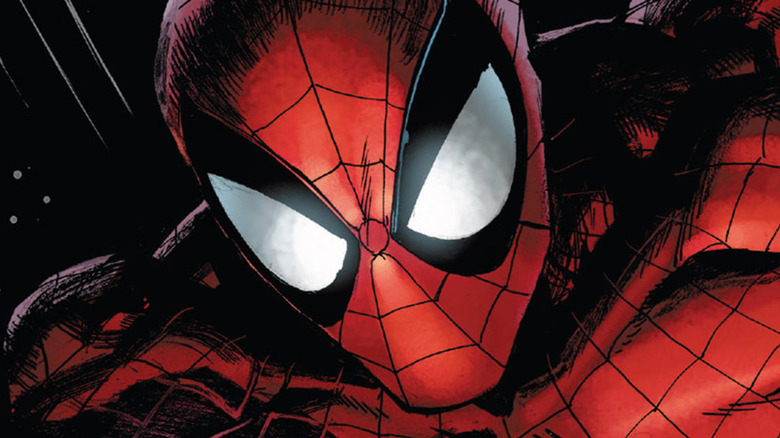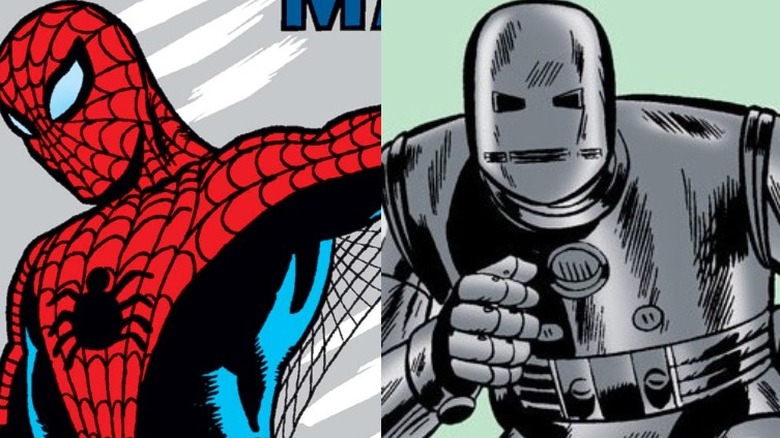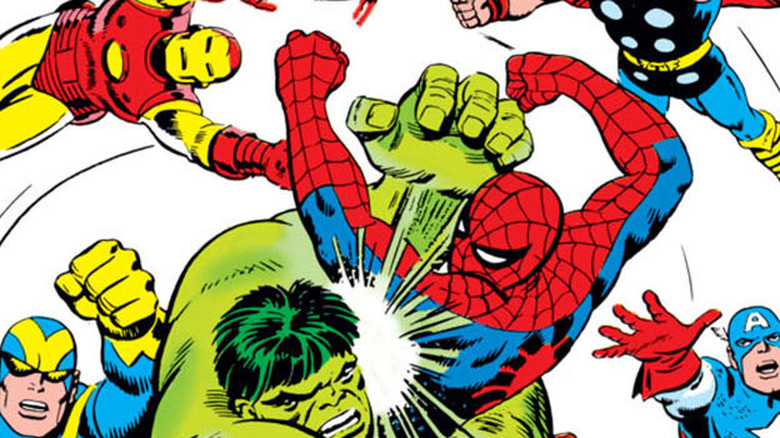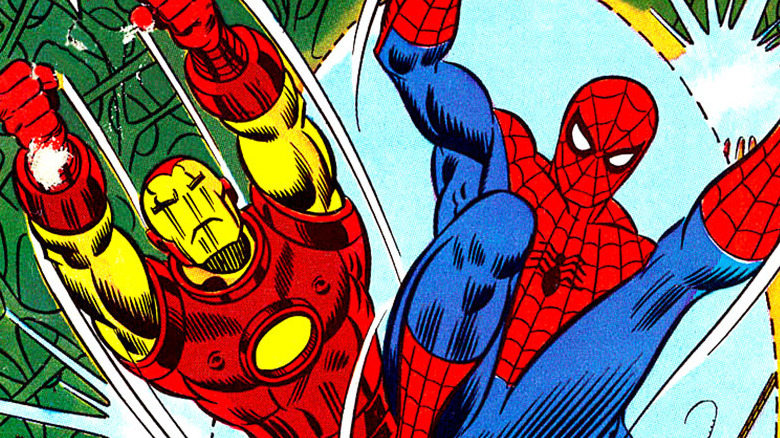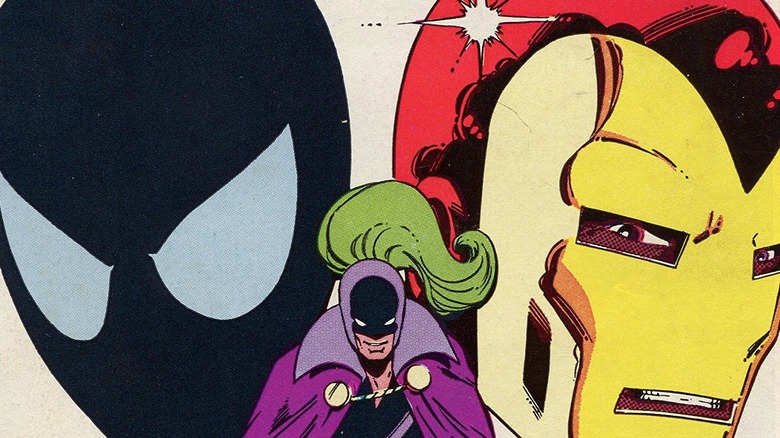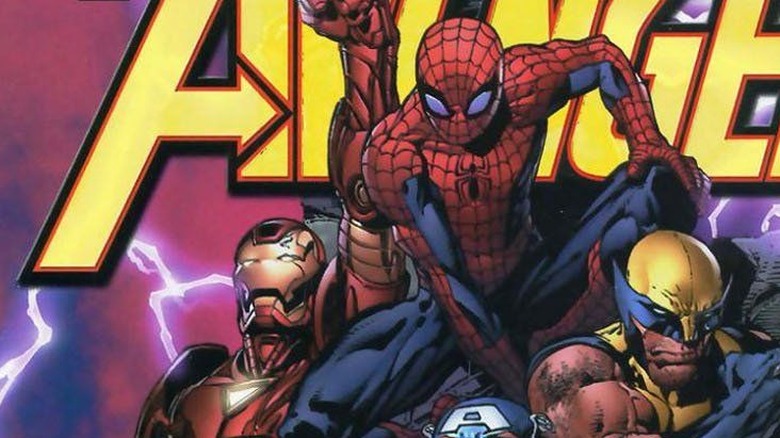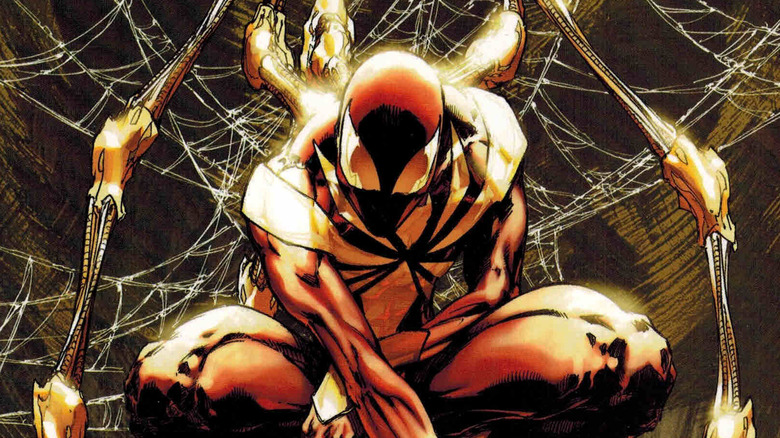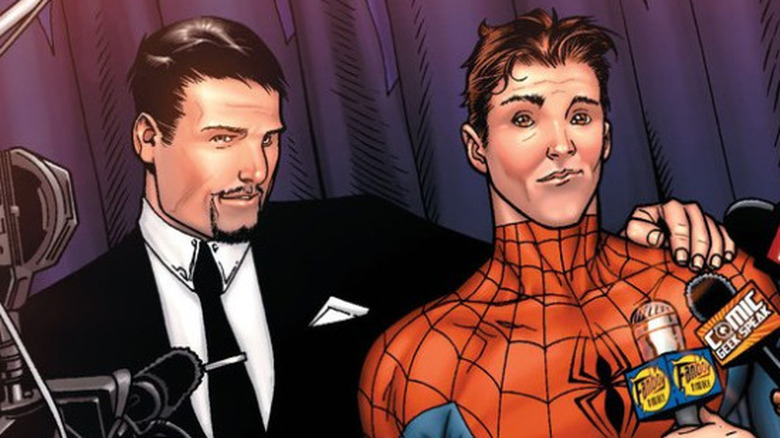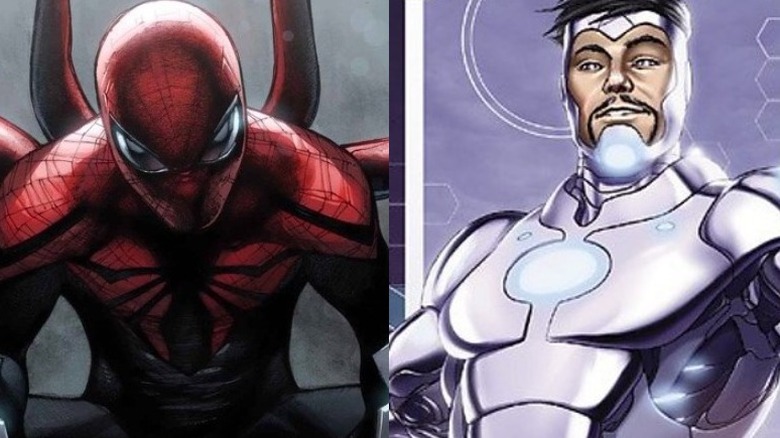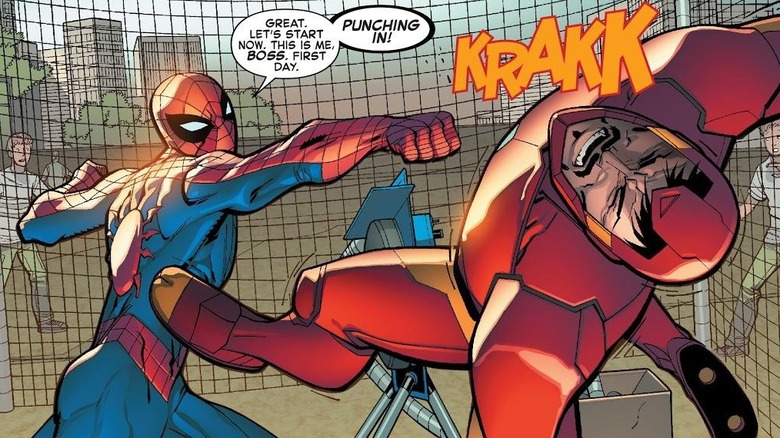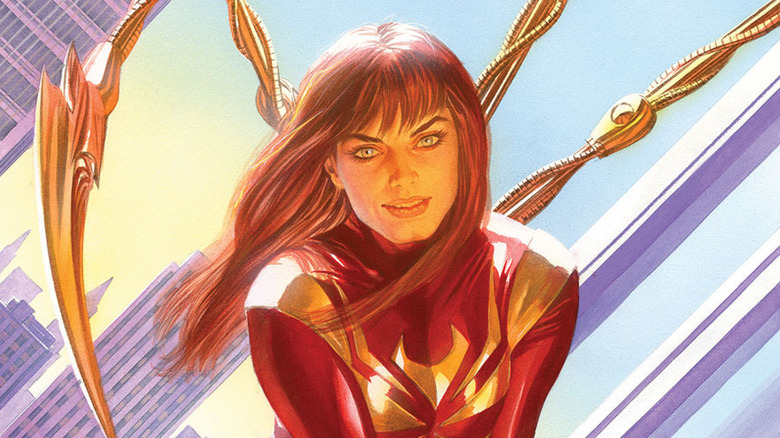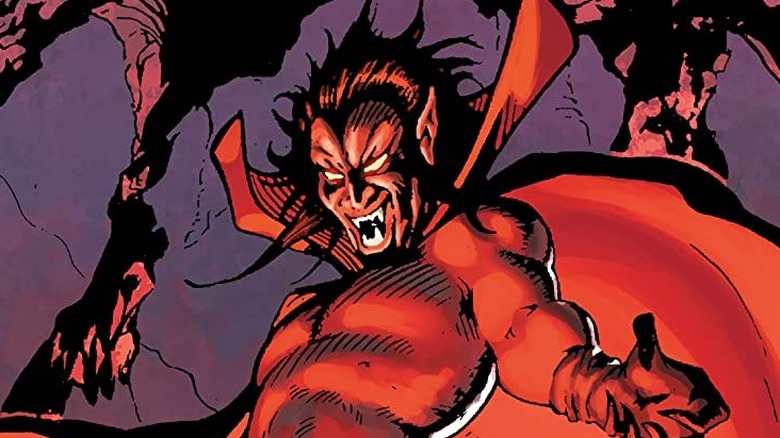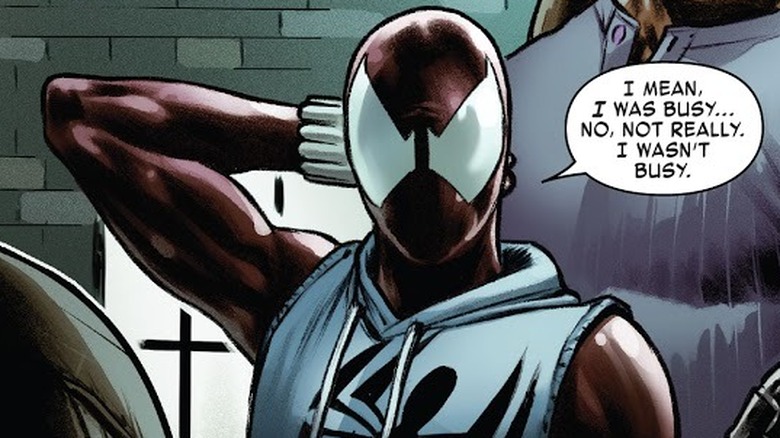The Untold Truth Of Spider-Man And Iron Man's Relationship
In the Marvel Cinematic Universe, Spider-Man is the Robin to Iron Man's Batman: an acrobatic youngster with untapped potential, taken by a tech-enhanced billionaire under his wing as his superheroic protégé. Due to the immense popularity of the films within this shared movie continuity, many new fans have come to strongly associate the wondrous webslinger with the armored Avenger.
However, while Tony Stark's role as Peter Parker's mentor and father figure covers virtually the entirety of their on-screen interactions, it only represents a brief segment of the relationship between the two superheroes in the source material. In fact, Webhead and Shellhead only started working side by side on a regular basis four decades after they first appeared in the comics — and weren't even that fond of each other in their early careers.
That said, it doesn't mean that the dynamic between these two Marvel characters was largely boring throughout most of their history. On the contrary, their occasional team-ups and brief stint as teammates notwithstanding, Spider-Man and Iron Man share more than a few connections that make them uniquely interesting parallels of each other. Here is the untold truth of Spider-Man and Iron Man's relationship.
Spider-Man and Iron Man: super scientists of the Silver Age
Spider-Man and Iron Man were both products of the early '60s Marvel superhero boom. Their co-creator, the late writer Stan Lee, often attributed their success to their relatability. Lee described them as a departure from the typical flawless demigods of the genre: "Heroes who were less than perfect ... Heroes who didn't always get along with each other, but heroes who could be counted on when the chips were down" (via BBC News). And these two characters — both of whom are men of science — are perhaps the best examples.
Spider-Man broke the superhero mold in more ways than one. Interestingly, his first appearance in 1962's "Amazing Fantasy" #15 only happened because it was the series' final issue. According to Nerdist, Marvel publisher Martin Goodman didn't want to run the story that Lee and artist Steve Ditko worked on, because he wasn't confident that a teenage protagonist based on an animal that "most people hated" would be a hit. Goodman eventually relented, though — and the rest, as they say, is history.
Meanwhile, Iron Man's 1963 debut in "Tales of Suspense" #39 introduced readers to a character that, by Lee's own admission, was intended to be unlikeable (via Screenrant): " It was the height of the Cold War. The readers, the young readers, if there was one thing they hated, it was war, it was the military. So I got a hero who represented that to the hundredth degree."
Misadventures with the Avengers
As more heroes began to populate Marvel's comics in the '60s, efforts to establish their shared universe became increasingly frequent. Thus, characters would sometimes appear in each other's books, whether in the form of team-ups or small cameos. 1964's "Amazing Spider-Man" Annual #1 was one such example, as it had Spider-Man briefly encountering Iron Man, Thor, Doctor Strange, the X-Men, and other superheroes in different parts of New York on his way to fight the Sinister Six.
"Avengers" #11, which came out in the same year, was a peculiar milestone in Spider-Man and Iron Man's shared comic book history. They both appear on the cover, but the armored Avenger isn't actually in the issue; meanwhile, it was Spider-Man's evil robotic doppelganger that played a bigger part in the story, with the original swooping in to save Captain America, Thor, Giant-Man, and the Wasp at the last minute. However, the wallcrawler doesn't even get to say a word to the Avengers in the issue.
Some time later, Spider-Man receives an invitation to join the Avengers in "Amazing Spider-Man" Annual #3. It becomes quickly apparent that at this point in their respective careers, Iron Man isn't particularly fond of Spider-Man. In fact, it's his dismissive comment that causes the young hero to lose his cool, nearly jeopardizing his potential Avengers membership. In the end, a misunderstanding causes Spider-Man to deliberately fail his test, thinking that he was acting for the greater good.
Spider-Man and Iron Man's first official team-up
It would be a few more years before Spider-Man and Iron Man could officially team up — appropriately enough, in the pages of "Marvel Team-Up" #9, published in 1972. What started out as a seemingly ordinary adventure quickly turned into a time-hopping disaster, as the two heroes found themselves thrown centuries into the future to put a stop to the Tomorrow War.
It's worth noting that neither of the two heroes is initially warm or cordial towards the other. In fact, their exchanges throughout their unexpected collaboration belie an undercurrent of mutual irritation, with Iron Man turned off by the webbed hero's talkativeness and Spider-Man being in a particularly bad mood due to personal troubles. Still, they manage to set aside their differences to defeat the instigators of the war — Kang the Conqueror and Zarrko the Tomorrow Man — with some assistance from the Human Torch and the Inhumans across the next two issues of the title.
The conflict between the two hotheads doesn't end there, though. Their argument escalates in 1976's "Marvel Team-Up" #48, with Spider-Man flat-out telling Iron Man that the armored hero and Thor irk him the most out of all of the Avengers. Iron Man, on the other hand, brings up Spider-Man's reputation as a secretive loner, which is why the former still finds it hard to trust the latter, despite having worked with him on multiple occasions.
A new guy as Iron Man, a new suit for Spider-Man
The early '80s brought major changes to both Spider-Man and Iron Man, with the webslinger rocking a new costume and a different person assuming the identity of the Golden Avenger.
"Iron Man" #170 marked the beginning of James "Jim" Rhodes' tenure as the new Iron Man, following Tony Stark's downward spiral into alcoholism. This became the norm until the series' 200th issue, in which Tony returned sporting a brand-new suit of armor. This also led to Jim participating in the cosmic brawl that took place in the 12-issue limited series "Marvel Super Heroes Secret Wars," alongside Spider-Man and select members of the X-Men, the Avengers, and the Fantastic Four. It was in issue 8 of the series when Spider-Man underwent a cosmetic change, in the form of a black costume with a white spider logo (which would later be revealed to be a symbiotic organism seeking to permanently bond with Peter).
After returning to Earth, Spider-Man and the new Iron Man find themselves working together in "Marvel Team-Up" #145. The two heroes face off against Blacklash, a disgruntled former Stark International employee with a tenuous grip on reality. The villain initially gives both heroes a difficult time, until they figure out that his deadly whips are powered by his gauntlets, which they handily destroy.
The New Avengers assemble
Aside from occasional guest appearances and crossover events, Spider-Man and Iron Man remained largely uninvolved in each other's activities in the '80s, '90s, and early 2000s. Interestingly, despite Spider-Man's status as a reserve Avenger, he was rarely called upon to join Earth's Mightiest Heroes on their numerous missions.
This changed in 2005, when a breakout at the maximum security supervillain prison called the Raft led to the formation of the New Avengers. By this time, the old Avengers team had disassembled, following the Scarlet Witch's massive reality-warping breakdown; the escape attempt by the Raft's super-powered inmates made Captain America and Iron Man realize that the world still needed a superhero team to defend it. Spider-Man officially joins the roster (and becomes a full-time Avenger for the first time) in issue 3, alongside fellow heroes Wolverine, Luke Cage, Spider-Woman, and the Sentry. As a team, they found themselves at odds with various threats such as the vampiric human-pterosaur hybrid Sauron, the magically enhanced, crowbar-wielding Wrecker, and even the criminal organizations Hydra and the Hand.
During this time, Peter moved into Avengers Tower with his Aunt May and wife Mary Jane. This change of address also contributed to him forming a deeper bond with Tony, whose scientific brilliance he respected. On his end, Tony saw much potential in Peter as both a scientific protégé and a superhero partner, and quickly took him under his wing as his new right-hand man.
Does whatever Spider-Man and Iron Man can
The father-son dynamic between Spider-Man and Iron Man resulted in the latter gifting the former with an unexpected upgrade: A new costume with incredible abilities that made the wall-crawler a much more formidable crime-fighter (albeit in Iron Man colors).
"Amazing Spider-Man" #529 sees Peter return to Avengers Tower after his temporary death. Inviting Peter to his lab, Tony unveils his newest creation: an "Iron Spider" suit with built-in emergency scanners, a mask filter, enhanced lenses, bulletproof and heat-resistant Kevlar, camouflage capabilities, and even arm-anchored mesh webbing gliders. The most striking design elements of the suit, however, are the three mechanical spider-arms ("waldoes") on its back, which can function as weapons, spy cameras, or gripping tools. Peter immediately puts the suit to the test, stopping a pair of armed hostage-takers in a getaway car with minimal effort.
Sadly, Tony's gift to Peter turned out to be a Trojan Horse of sorts. "Amazing Spider-Man" #536 shows that Tony built a remote shutdown function within the suit; fortunately, Peter was a step ahead, anticipating this and incorporating his own passcode to override Iron Man's control. Worse, a subsequent skirmish revealed that Iron Man secretly used data from the Iron Spider suit to analyze the webslinger's powers, and was able to develop technology that could fool Spider-Man's famed spider-sense ("Civil War" #5).
The unmasking that destroyed a friendship
When the superhero community could not agree on the ideal way to ensure their accountability, a superhuman Civil War broke out — and Peter Parker's bond with Tony Stark was one of the biggest casualties.
As the right-hand man of Iron Man, the chief proponent of the Superhuman Registration Act, Spider-Man decided to make the strongest statement of support possible. In "Civil War" #2, the webslinger unmasks before the world, revealing his civilian name and admitting to being Spider-Man ever since he was a teenager. This move sends ripples across the superhuman community, subsequently throwing Peter's personal life into chaos as villains left and right started gunning for him and his family. Throughout this difficult time, Tony assures him that he and his family would be protected — that is, until Peter decides to switch sides in "Amazing Spider-Man" #536 after personally witnessing the atrocities Tony commits in order to achieve his goals. Unsurprisingly, this act of betrayal completely shatters their relationship.
By the time the war ends, Spider-Man is one of the surviving heroes who suffers the most. Not only do he and his family become fugitives, but his Aunt May also comes close to dying after an assassin's bullet hits her. Left with no other options, Peter and Mary Jane make a deal with the devil to save his aunt and make the world forget his secret identity, at the cost of their marriage.
Superiority complex
Despite the termination of their friendship, Spider-Man and Iron Man's lives continued to parallel each other in numerous ways. For instance, both heroes underwent a phase in which they weren't quite themselves, engaging in acts that were borderline villainous under the pretense of making the world a better place. In both cases, it was because of an evil seed inside them: A supervillain hijacking Peter's body, and Tony's evil side taking charge.
In "Amazing Spider-Man" #700, a dying Doctor Octopus successfully escapes his ultimate fate by switching minds with Peter Parker. Despite Peter's best efforts to reclaim his body, he fails, but not before imparting an important lesson to Doc Ock. As a result, the ex-villain experiences a change of heart, resolving to become a Superior Spider-Man. He takes over Peter's life and pretends to be Spider-Man, applying his scientific genius to develop efficient but morally dubious crime-fighting methods. Eventually, the real Peter returns; Doc Ock willingly relinquishes control, acknowledging that the original was truly the superior one, after all.
Meanwhile, Tony's Superior transformation was the result of being caught within range of Scarlet Witch's morality inversion spell, a last-ditch effort to defeat the immensely powerful Red Onslaught. "Superior Iron Man" #1 shows him fully becoming the Superior Iron Man, a manipulative villain with a powerful new suit of armor. Some time later, a cosmic reset of the Marvel multiverse kills the character, restoring Tony to his normal, heroic self.
Rags to riches, riches to rags
For most of their publication history, Spider-Man and Iron Man have had contrasting relationships with money: Peter Parker is almost always out of it, while Tony Stark is almost always swimming in it. However, there have been instances in these characters' lives in which the reverse became reality, leading to some interesting status quo shake-ups.
Following Peter's return as the true Spider-Man after Doc Ock takes control of his body, he becomes the CEO of Parker Industries, the company that his former foe established in his name. "Amazing Spider-Man" #1 (Vol. 4) gives readers a glimpse of Peter's life as a billionaire technologist, as well as how his new status enables him to be a more effective crime-fighter. Sadly, Peter's company did meet its demise at his own hands, as he destroys all of Parker Industries' systems and research to prevent Doc Ock from exploiting them. Tony Stark actually predicted this, as he once stated how he expected Peter to inevitably mess up and tank his own business.
However, it's not as if Tony has always been at the top of the food chain. One noteworthy example is Obadiah Stane's takeover of Stark International in "Iron Man" #173, which left Tony homeless for a time and forced Jim Rhodes to take over as Iron Man. Tony eventually bounced back, though, returning 27 issues later in a new Iron Man suit to defeat his corporate rival.
The Mary Jane connection
Mary Jane Watson has been a significant part of Peter Parker's life since her first full appearance in "Amazing Spider-Man" #42. One of the few supporting Spider-characters who was secretly aware of Spider-Man's true identity, the actress-slash-supermodel became Peter's confidante, lover, and partner for the greater part of his adult life. However, there was a brief period of time when she became a major part of Tony Stark's life as well, albeit in a strictly professional sense.
In "Invincible Iron Man" #4 (Vol. 3), an explosive battle involving Iron Man, Doctor Doom, and Madame Masque destroys Mary Jane's new Chicago nightclub Jackpot, which she established after her previous nightclub in New York, MJ's, was similarly blown up by a super-powered brawl. To her shock, Tony offers her a job as his personal assistant some time later, which she accepts (much to Peter's chagrin).
Ironically, it is this unexpected career move that ends up saving the lives of both Spider-Man and Iron Man. In "Amazing Spider-Man" #15 (Vol. 4), the webslinger and the armored Avenger are at the mercy of the costumed villain called Regent. Realizing that no other hero can come to their rescue, Mary Jane searches the crates from Avengers Tower and finds Peter's old Iron Spider suit. Emboldened by her previous experiences in operating an Iron Man suit and temporarily gaining spider-powers, she wears the suit and charges into battle, helping Spider-Man and Iron Man gain the upper hand.
Manipulated by the deceitful Devil
The powerful demon Mephisto has directly meddled in Spider-Man's affairs, initially for mysterious reasons. In order to prevent Aunt May's death from a bullet wound, Peter and Mary Jane made a deal with him in "Amazing Spider-Man" #545, sacrificing their marriage to make the world forget his secret identity and save May's life. "Amazing Spider-Man" #74 (Vol. 5) reveals why the Lord of Darkness wanted to tear Peter and Mary Jane apart: He had been having visions of Spider-Man's future daughter bringing his empire down, and wanted to prevent her from existing in the first place.
Spider-Man isn't the only superhero that the Prince of Lies has messed with on a personal level, though. 2013's "Iron Man" #17 (Vol. 5) exposes Tony Stark's secret origin: He was actually adopted by Howard and Maria Stark. The couple tragically died in a car accident when Tony was just 21 years old, long before the future Avenger could discover the truth about his parentage.
However, Howard managed to survive his brush with death, as he was secretly a worshipper of Mephisto. In "Avengers" #31 (Vol. 8), the Great Corruptor appears before Tony and tells him that his adoptive father had actually sold Tony's soul to him years earlier; the end of the issue shows the older Stark alive and well, ready to do his master's bidding.
Not-Spider-Man joins the Not-Avengers
Spider-Man and Iron Man may not always be on good terms, but they can at least acknowledge when they need each other's help. However, when a cosmic villain resurfaces to reshape the universe according to his whims, Iron Man is forced to seek assistance from unexpected allies — including the webslinger's genetic duplicate, Ben Reilly.
After realizing that the key to defeating the powerful Avengers villain Korvac is the element of surprise, Tony decides to assemble a team of costumed adventurers beneath the former demigod's radar. Thus, in "Iron Man" #5 (Vol. 6), Tony contacts low-profile heroes Gargoyle, Misty Knight, Frog-Man, and the Scarlet Spider to help him and Hellcat disrupt Korvac's plans.
This space-spanning adventure takes place before Ben reclaims the mantle of Spider-Man in "Amazing Spider-Man" #75 (Vol. 5). Still, this proves that whenever Iron Man is in a pinch, Spider-Man — or at least some version of him — is someone he can rely on.
